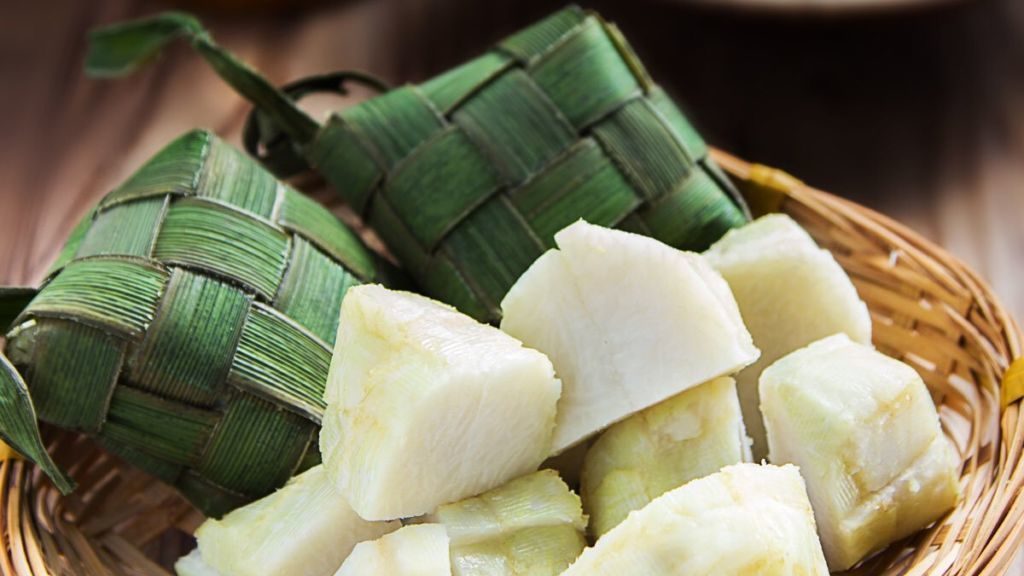Ketupat is one of the famous Malay delicacies that usually enjoyed during the celebration of Hari Raya. It comes in different sizes, fillings, and shapes. The fillings can be either rice or glutinous rice. Ketupat is often enjoyed with rendang, peanut sauce or as it is.
What is Ketupat?
Ketupat is termed as a type of rice dumpling that is made from either rice or glutinous rice. The rice is packed in woven palm leaves and then boiled to cook. As the rice cooks, the grains expand and fill the pouch. Ketupat is famously served with rendang, a type of dry curry made from either beef or chicken. It is also served as an accompaniment to satay or gado-gado.
History of Ketupat
The use of woven palm leaves to store food is attributed to seafarer in Maritime Southeast Asia. This type of cooking allows them to keep the cooked rice from spoiling during the long sea voyages. The rice is usually wrapped into a triangular or diamond form and stored hanging in the open air, allowing the rice to last longer.
The connection of Ketupat with the celebration of Hari Raya began in the 15th century during the Demak Sultanate (Indonesia). There is an appropriate symbolism in Ketupat as ‘kupat’ in the Javanese language means admitting one’s mistakes. The woven palm leaves represent the trespasses whereas the filing, rice represents the purity of heart of forgiving one another of those trespasses.
Varieties of Ketupat
Among the significant variations of ketupat are ketupat nasi and ketupat pulut. Ketupat nasi is also called as nasi impit. It is made from white rice and is wrapped with coconut palm leaves. Ketupat nasi is in a diamond-shaped form and served by cutting it into cube-shaped. It is typically served as an accompaniment to satay, Soto or gado-gado. Some might enjoy ketupat nasi with serunding (dry fish or chicken flakes).
Ketupat pulut is also known as ketupat daun palas in Malaysia. It is made from glutinous rice wrapped with fan palm leaves (daun palas). It is triangular and can come with varieties of fillings. Besides using white glutinous rice, the northern side of the Peninsula used black glutinous rice to make the ketupat. Other than that, some people like to mix the glutinous rice with corns and peanuts to give extra flavour to the dish. Ketupat pulut often served with rendang, peanut sauce, and chicken curry.
Other than the ketupat mentioned above, there is ketupat sotong (squid) that is famous in Kelantan and Terengganu. The squid stuffed with glutinous rice and cooked in creamy coconut milk gravy. The Kelantan version has brownish gravy due to the usage of palm sugar while Terengganu is just plain coconut milk. This is the only ketupat that is not wrapped with palm leaves or coconut leaves.
The lesser-known ketupat is ketupat Borneo or burasak. Ketupat burasak is famous among Bugis ethnic in Sabah. It is made using rice and coconut milk which then wrapped with banana leaves. It is typically eaten with Asam pedas ikan (sour and spicy fish stew), and also with fish flakes.
Where to find Ketupat in Malaysia
Ketupat is mostly available in any Malay restaurants throughout the country. During the festival seasons, you can find many street vendors that sell ketupat. Try either ketupat nasi or ketupat pulut from Rumah Ketupat Cafe (Shah Alam).
If you love satay, try the ketupat nasi with satay from Yut’s Satay (Puchong). If you are craving for more ketupat dishes, log on to foodpanda and have them delivered right at your doorstep.
